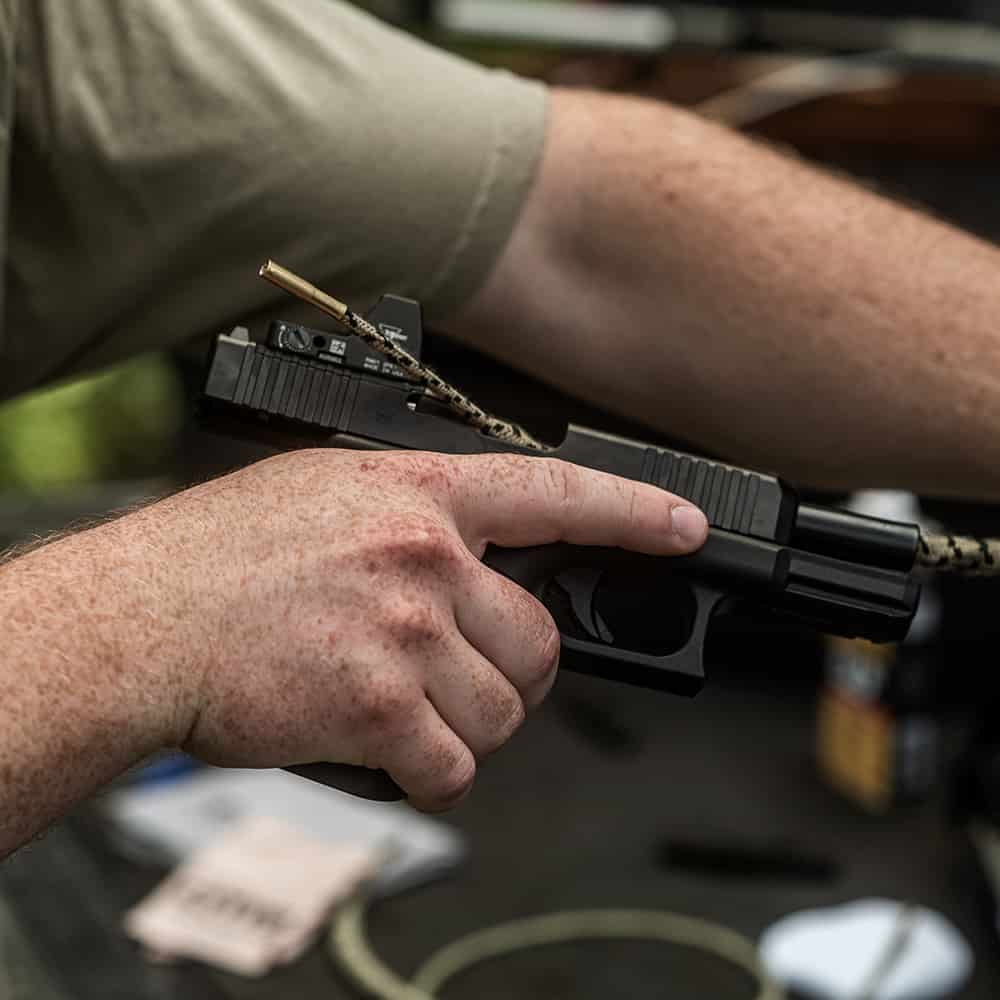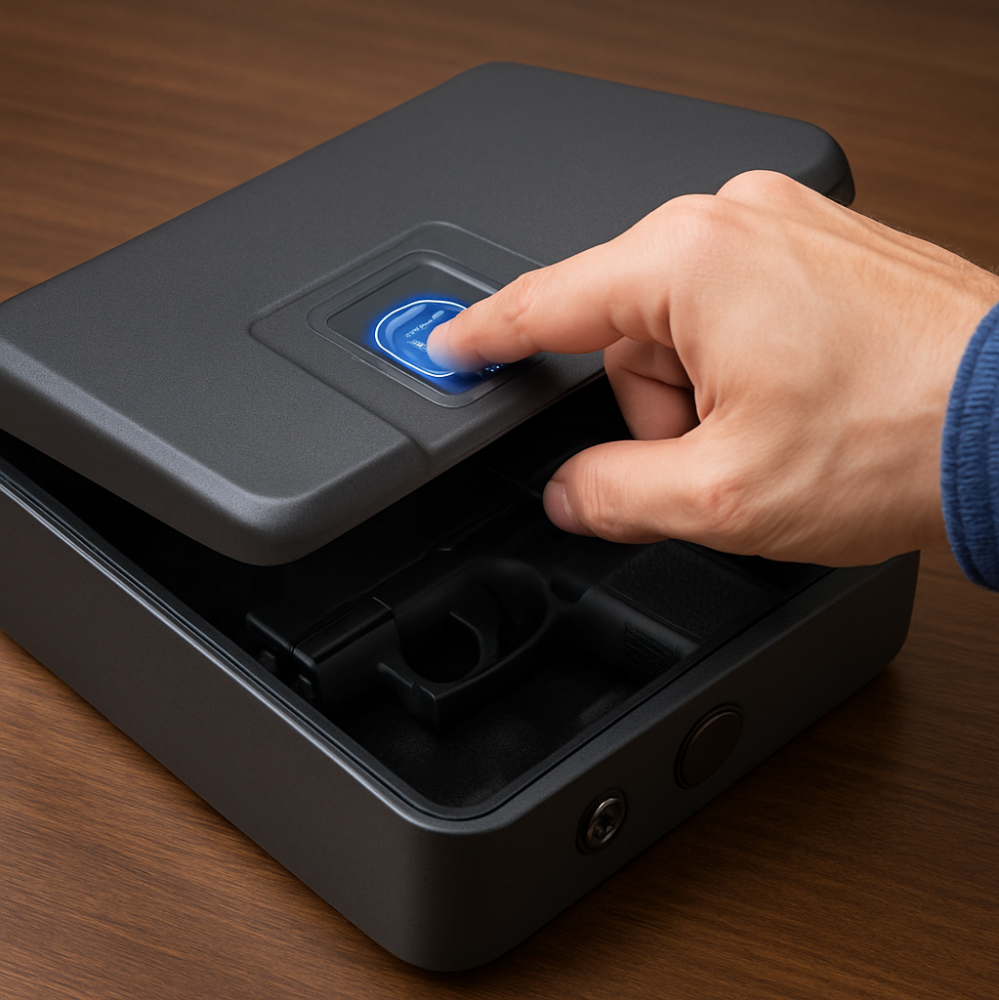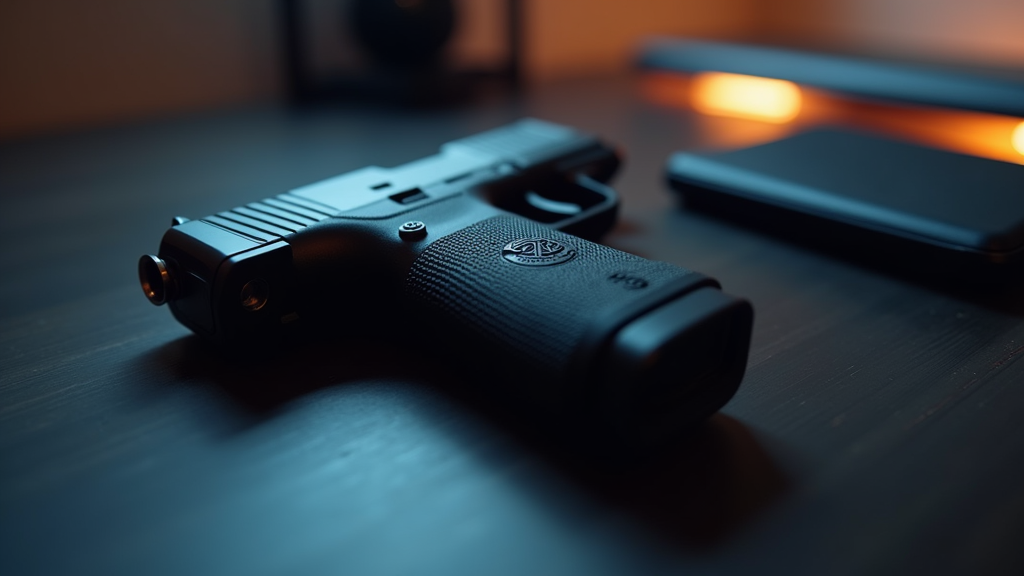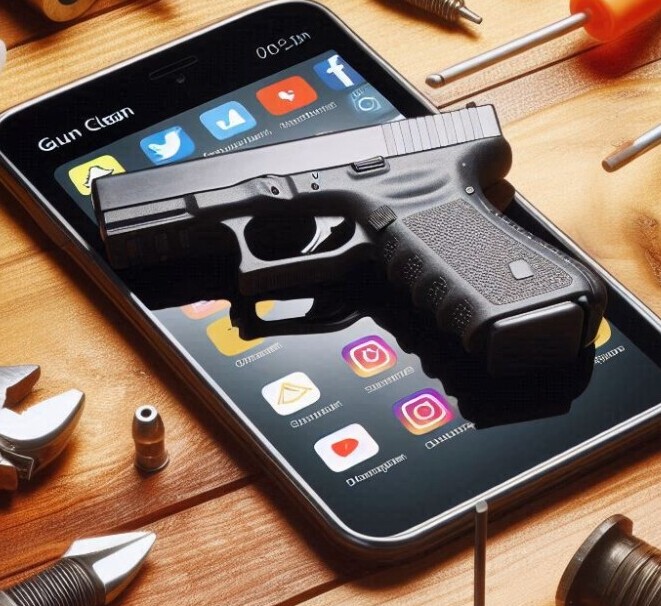If you’re a hunter, sport shooter, or member of the military or police force, then you know the importance of keeping your firearm clean and in good working order.
In this article, we’ll show you how to clean your pistol safely and effectively. We’ll also show you what supplies you need and how to properly store your firearm after cleaning it
So, whether you’re a first-time gun owner or a seasoned veteran, read on for tips on how to clean your pistol like a pro!
How Many Types of Handguns Are There and How Are They Used
- Single Shot Break Action Pistol
- Revolver
- Semi-automatic Pistol
How is each type of handgun used?
A single shot break action pistol is a one-shot handgun that has to be reloaded after every round fired.
They are popular for hunting and target shooting as they can be loaded with very specific rounds, such as shotgun shells or .45 rifle rounds.
The firing pin on this type of handgun strikes the back of the cartridge which makes it easy to remove and replace the spent cartridge.
This type of weapon does not eject or unload itself so it is important that you remember to remove the magazine before cleaning your gun if you want to avoid damaging it.

Revolvers come in many shapes and sizes but all operate the same way: rounds are loaded into a rotating cylinder, each chamber is primed with gunpowder and each round is struck with the firing pin.

A revolver’s cylinder rotates by pulling back the hammer, which makes using this type of handgun easier for people who have weak wrists.
A semi-automatic pistol is a one-shot handgun that reloads automatically after each round has been fired.
The rounds in a magazine are fed into the chamber and then ejected after being struck by a firing pin.
Some shooters find it difficult to rack a slide on a semi-auto, but magazines make racking much easier as they do not need to load their gun from rounds held within the magazine itself.
Like revolvers, semi-automatics come in many shapes and sizes depending on what features you want your gun to have.
Semi-automatics are the most common handguns used in law enforcement and self-defense situations.

How to Clean Your Single-shot Break Action Pistol
We are going to go over how to clean your single shot break action handgun. The steps below are the same for every type of single-shot break action pistol.
What You Will Need:
Gun oil or solvent, q-tips, towel, gun brush, cleaning rod/kit and a small screwdriver set. All these items can be found at Walmart or even the dollar store so it won’t cost much to get started.
Or, if you just want to get a universal handgun cleaning kit you could look on this web page; Best Universal Gun Cleaning Kits.
Look at the bottom of the page for the bonus handgun kit.
Also take note that not all pistols have screws on them but if yours does then you will need that tool as well to take apart your single shot break action pistol properly.
To use proper safety while cleaning your pistol make sure you put on safety glasses before you start.
Let’s take our single shot break action pistol apart.
For this we will use the G2 Contender as an example. The G2 Contender can be broken down into three basic groups:
- The Frame Assembly – it is held on the stock by a stock draw bolt. The fire control mechanism (hammer, sear, firing pin, …) is housed within the frame and the hinge pin.
- The Barrel – is held by the receiver by the hinge pin that anchors the barrel lug to the frame.
- The Grip or Stock Assembly – composed of the grip/stock and forend.
When in doubt, always have your owner’s manual handy and refer to it for the most accurate instructions and illustrations.
First, you will inspect it to make sure it is not loaded.
With your finger away from the trigger, with the hammer in the “AT REST” position and the firing pin selector in the center position (SAFE), open the action by pulling up and back on the trigger guard spur – this allows the barrel to fall open.
Look into the barrel from the breech end (the end where you grip the pistol when shooting) to make sure there is no cartridge in the chamber.
Inspect and confirm that the bore is clear and free of obstructions.
You follow this procedure every time the firearm leaves your hand, is cleaned, handed to you or someone else, and transported or stored. There are no exceptions!
To remove the barrel you will first need to uninstall the forend. Close the barrel on the frame. Remove the two screws (turning counter-clockwise) that are holding the forend to the barrel.
Reopen the barrel to remove the tension on the hinge pin and remove the barrel hinge pin by tapping it out from either side. Remove the barrel from the frame.
Cleaning the Gun
Using a properly fitted brass brush dipped in gun cleaning solvent, remove excessive firing residue from the bore and chamber. Finish the bore cleaning process by running a dry cotton cloth patch through the bore to remove residue and solvent.
Clean the outside of the gun using a non-abrasive cleaning cloth. A piece of an old flannel shirt works well for this.
After cleaning, put a light coat of high quality firearm oil on the internal and external metal parts.
Anytime your gun has been exposed to sand, dust, water, extreme humidity, or other adverse conditions, it must be cleaned and lubricated.
Pistol Re-assembly
You will reassemble the pistol in reverse order that you took it apart.
Storage of your Single-shot Break Action Pistol
When storing your firearm, do not put it in anything that will attract moisture.
This includes leather and heavy cloth. Do not store the gun with a plug inserted in the barrel either because this can cause moisture to accumulate over time.
If you’re storing your gun for a long time, you should oil the bore, chamber and internal surfaces with a high-quality lubricant or preservative meant for firearms.
You should also coat the external parts like the receiver, bolt and barrel with an anti-rust oil before putting it away. Finally, make sure to clean your gun before using it again.
Always store your firearm unloaded and locked away when you are not using it, a good safe is perfect for this.
This is for your safety and the safety of others. Make sure to keep it in a place where unauthorized people cannot get to it.
If you have to leave it somewhere, make sure it is locked, unloaded, and secure.
How to Clean Your Revolver
Let’s disassemble our revolver for cleaning
For our example this time we will use our Ruger Security Six revolver. The Security Six can be broken down into four basic groups:
- Barrel and Cylinder Frame
- Cylinder
- Hammer
- Trigger Guard Assembly
Once again, always have your owner’s manual handy and refer to it for the most accurate instructions and illustrations.
First, you will inspect it to make sure it is not loaded.
Uncock the revolver
Press the crane latch and guide the cylinder out as you would for loading.

Push the head of the ejector rod smartly toward the rear of the cylinder until it stops.
This will eject any cartridges or fired cases.
NOTE: Do not eject live cartridges onto any surface where a primer might strike a solid object and discharge the cartridge.
When ejecting fired cartridge cases, put the revolver at a high angle in order to help the cases come fully out of the chambers and not slip under the ejector.
You do not need to do this for unfired cartridges because their weight and gravity will do the job.
Disassembling the Security Six revolver
After ensuring the revolver is unloaded, close the cylinder.
Using the correct size screwdriver, remove the grip screw and lift grip panels from the frame of the weapon.
Cock the hammer.
Insert the disassembly pin about 1/2 its length into the hole at the lower end of the mainspring strut. If you no longer have the disassembly pin, a small phillips screwdriver will work, as well.
With your thumb on the hammer spur, squeeze the trigger allowing the hammer to go fully forward.
Lift out the mainspring assembly. NOTE: Do NOT remove the disassembly pin until the mainspring assembly is reinstalled in the revolver at the time of reassembly.
Pull trigger and remove (push out) hammer pivot while holding trigger in rearward position.
Lift the hammer out of the frame while trigger is in rearward position.
Use the mainspring assembly to depress the trigger guard lock plunger located inside frame at rear of trigger guard. At the same time, pull out and remove the trigger guard assembly.
NOTE: If you are unable to apply sufficient force to depress the plunger using the mainspring assembly as a “tool”, then use an appropriate sized screwdriver.
Cradle the revolver frame in your left hand and, with the thumb of your right hand, press the cylinder release button, swing out the cylinder assembly and move it forward, thereby removing it from the frame.
The cylinder latch will drop from the frame into the palm of your hand.
This is as far as you need to go for cleaning and it is not recommended to further disassemble the revolver.
Cleaning the barrel of your revolver
To begin lets start with the barrel of your revolver which is the most important part since that’s where projectiles are fired from.
Clean the barrel from the muzzle by running a cleaning rod with a solvent coated patch through the bore several times.
A .38 caliber bronze wire brush attached to the cleaning rod should then be pushed the full length of the bore several times.
Again swab the bore with a solvent coated patch. Then wipe the rod clean and, using a dry patch, swab the bore until it is clean.
Examine the bore to be sure that no fouling remains.
This should be done every so often when firing your gun more than five hundred times in order to get rid of any particles that could potentially cause malfunctions.
Cleaning the cylinder of your revolver
Clean the cylinders by running a cleaning rod with a solvent coated patch through the each cylinder several times.
A .38 caliber bronze wire brush attached to the cleaning rod should then be pushed the through each cylinder several times.
Again swab the cylinders with a solvent coated patch.
Then wipe the rod clean and, using a dry patch, swab each cylinder until they are clean.
Examine each cylinder to be sure that no fouling remains.
Cleaning the frame and other parts of your revolver
For this you can use q-tips or pipe cleaners.
Note: Some 357 Magnum cartridges with lead bullets tend to deposit metal fouling in the chamber throats, in the forcing cone of the barrel area, and in the bore.
If this “leading” is seen in your revolver, clean it out before it builds up and interferes with the reliable functioning and accuracy of your Ruger Security Six.
A special “lead removing” cleaning tool (for bore and chambers) may be available from your local gun store or online.
Storing your revolver properly to keep it in good condition
Don’t keep your revolver in a leather, canvas, or fabric holster when it is stored. These materials attract moisture, even though they may appear as if they are perfectly dry.
Regularly, or when the gun is exposed to sand, water or other bad conditions, disassemble it and clean and oil it as described above.
Ruger went through the trouble of designing the revolver to be easily disassembled and reassembled so the gun owner would better clean and maintain it.
Always store your firearm unloaded and locked away when you are not using it.
This is for your safety and the safety of others.
Make sure to keep it in a place where unauthorized people cannot get to it. If you have to leave it somewhere, make sure it is locked, unloaded, and secure.
Care of Stainless Steel Revolvers
Stainless steel revolvers are more resistant to corrosion than blued steel revolvers.
However, it is important to inspect your revolver frequently and clean it as needed. You should also apply a rust preventative as necessary.
Some people may notice surface discoloration on stainless steel revolvers, which is caused by sweat or contact with certain types of holsters.
Rusting may also occur if the revolver is exposed to moisture or chemicals.
Minor discoloration can usually be removed by rubbing the stained area with an abrasive ink eraser, crocus cloth, or a “metal polishing” compound.
When using any of these abrasives, proceed with care and use light pressure to achieve a blending of “color” with those areas that are not discolored.
Clean the outside of the barrel, frame, and cylinder after you have used it.
If you are going to store it, use a light coat of oil or preservative before putting it away.
If the revolver will still be used and there is oil or grease around it, you can coat the external surfaces with a paste wax.
Apply the wax sparingly, allow time for it to dry hard, then buff it out with a cloth.
Do not get the wax on any moving parts of the gun while applying it.
A hard wax coating applied correctly will not interfere with how comfortably you handle the gun, and it will help to prevent rust or discoloration.
How to Clean Your Semi-Automatic Pistol
Make sure your pistol is unloaded and pointed in a safe direction

Since there are so many different semi-automatic pistols I’m not going into detail on disassembly or cleaning at this time.
However, in the future I will be making videos of the process as I gain exposure to more handguns with the local gun club.
Remove the magazine and lock the slide back
Clean the barrel with a cleaning rod and patches
Clean the recoil spring and guide rod
Clean the firing pin channel
Inspect all parts for damage or excessive wear
Storing your semi-automatic pistol
The same things apply to the semi-automatic pistol as they do the revolver.
Don’t keep your revolver in a leather, canvas, or fabric holster when it is stored.
These materials attract moisture, even though they may appear as if they are perfectly dry.
Regularly, or when the gun is exposed to sand, water or other bad conditions, disassemble it and clean and oil it as described in the manufacturer’s documentation.
Conclusion
When it comes to handguns, there are a lot of different types and models. There’s the Single-shot Break Action Pistol and the Revolver, for example.
These guns require slightly different cleaning procedures than other firearms because they only use one round per firing cycle as opposed to several rounds like some semiautomatic pistols or rifles do.
If you’re looking for an easy way to clean your handgun without having to worry about ruining your firearm with improper technique, we recommend picking up a quality gun cleaning kit from Amazon Prime Now!
The kits come in all shapes and sizes so that no matter what type of pistol you have or how often you shoot, there is something out right now just waiting for you to buy it.
We want all our readers to be safe while handling firearms so make sure to read this article on best practices for safety.
Have any tips about properly caring for your own firearm? Share with us below!
Be sure to subscribe to Les Waller International YouTube channel and look for other gun related videos. To date we’ve visited the Heym and Blaser gun factories in Germany and put related content on our YouTube channel.
FAQ
Should I clean my pistol?
Yes, regular pistol cleaning is crucial for maintaining reliability, accuracy, and safety. Cleaning removes residue, fouling, and prevents corrosion to ensure optimal performance.
Can you overclean a gun?
Excessive cleaning can lead to unnecessary wear on gun components. Clean your gun as needed, following manufacturer recommendations and common-sense guidelines.
What happens if I don’t clean my gun?
Neglecting gun cleaning can cause malfunctions, reduced accuracy, and potential safety risks due to the buildup of fouling, debris, and corrosion.
Is 9mm better than 45?
The choice between 9mm and .45 caliber depends on personal preferences, intended use, and shooting skills. Both have pros and cons, so choose what suits your needs.
How many rounds does it take to clean a gun?
There’s no fixed number of rounds to clean a gun. The frequency of cleaning should depend on the type of firearm, usage, and environmental conditions.
Should you clean gun immediately?
If possible, cleaning the gun immediately after shooting is recommended to prevent fouling and corrosion. However, if not feasible, clean it as soon as possible.
How often should I clean my Glock?
The frequency of Glock cleaning depends on usage. A general guideline is to clean it after each shooting session or at least once a month if not in use regularly.
Is a clean gun more accurate?
Yes, a clean gun generally performs more accurately because debris and fouling can affect the barrel’s precision and disrupt bullet trajectory.
Can you use Vaseline to clean your gun?
Vaseline is not suitable for gun cleaning. It can attract dirt, cause malfunctions, and degrade certain materials. Use proper gun cleaning solvents and lubricants instead.




Leave a Reply